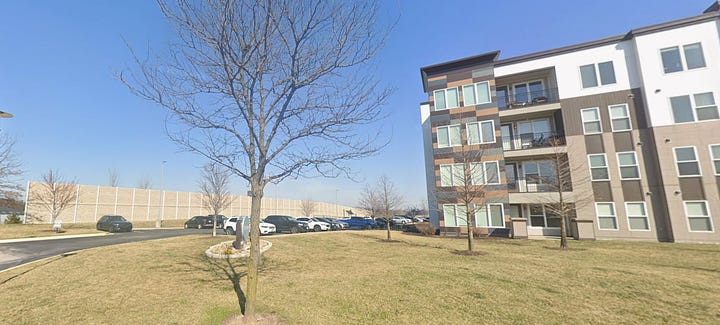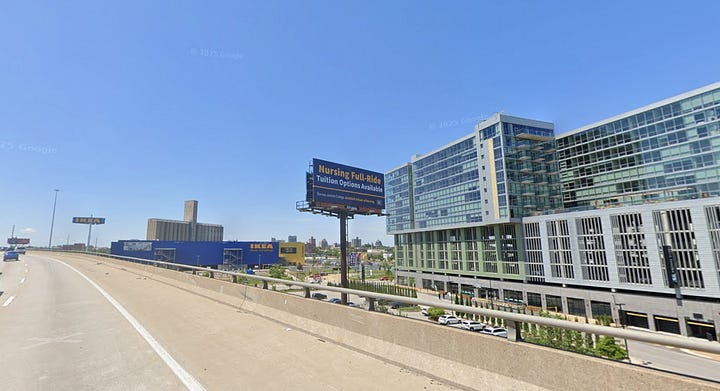I’m visiting family in Los Angeles right now. I grew up in LA before moving to St. Louis. In the last decade, the west coast metropolis has made numerous positive changes to its urban environment.
The city is investing heavily in building out its rapid transit. It’s taking (some) meaningful steps toward ameliorating its unhoused crisis. Driving down (the) 405 or (the) 101 highways, it’s obvious that several new - and very large - housing developments have taken shape as well.
These changes are great, but they also expose a dirty set of priorities not unique to Los Angeles, but instead reflective of most U.S. cities.
So, what am I even talking about here? What’s the critique?
We’re showing remarkably little care for renters in most U.S. cities, and our zoning regimes are a major part of the problem. The even bigger culprit is our set of values. I don’t know how to fix that one, but it’s probably true.
While it’s great that cities are building new apartment buildings in U.S. cities like Los Angeles, the quality of these housing options is dubious. In fact, on our drive from the airport, there were multiple instances of large and new apartment buildings being so close to the highway that we could practically hop right inside from the edge of the highway walls.
There are hundreds of housing units within striking distance of highways. This matters because we are subjecting renters to catastrophic health contaminants. The air and noise pollution never stops, and the residents similarly do not have as much access to healthy amenities like greenery, bike lanes, and quiet.1 Worse yet, these renters are overrepresented by low-income and minority households.2
Our zoning systems are responsible because it is primarily along these high-capacity car arterials that we allow for higher density housing options. We do not allow these lower-income, higher percentage minority groups to live in more desirable neighborhoods with better amenities and health outcomes. Well - we do, in that we don’t explicitly say “group XYZ cannot live in this neighborhood anymore”, but because of existing inequities in our society, we effectively reach the same outcome through ordinances that appear to be color-blind.
Everything in the zoning map above in the yellow shade is low density residential. There are clusters of higher density zoning designations only surrounding higher capacity arterial roads that are not in neighborhoods, but rather just outside of them and adjacent to worse pollutants.
To be clear, we do this everywhere. Lots of the newer, high density apartment buildings in St. Louis are directly next to highways.


You’ll notice this wherever you are.
We do so much to make life worse for our renters. We outright regulate where they may reside by determining that new units can only be built in highly specific, downright unhealthy locations.
We also make certain that they pay for things they don’t even need through onerous parking requirements. If you’re unfamiliar with this type of rule, here’s how it works. In most cities, zoning ordinances require that each residential unit has a specific amount of provided parking spaces. The justification is to prevent a spilling over of parking upon neighboring parcels.
In practice, this ends up with apartments often having 1, or sometimes 2 or more parking spots per residential unit. It doesn’t matter if the apartments are directly adjacent to a university or rapid transit stop, or even if the residents are unable to afford cars for these spots in the first place. In St. Louis, which as one might note is quite car dependent, our new apartment buildings typically have much room to spare in their lots. Developers even admit to such.
This is a problem because parking spots are far from free. Instead, the cost for an individual parking stall in St. Louis can often exceed $40,000 dollars. If you require 2 spots per unit, then you’re offloading perhaps $80,000 in costs to renters that is often completely unwanted and/or unused.
We are increasing their rent, determining their own needs for them. It’s both paternalistic and costly.
Between raising their costs, excluding them from desirable neighborhoods, and inflicting harm upon their health outcomes, we’re doing a lot of damage to renters in our cities.
It’s not an impossible problem to solve, either. First, we have to admit what it is we’re doing and what values we are demonstrating.
If we want to have more equitable outcomes and opportunities for less privileged groups, then we need to acknowledge that our land uses are an obstacle.
We then must expand housing choices across our cities, especially in neighborhoods that are highly restrictive in their zoning designations. Doing so will gradually integrate communities, reduce burdens on housing costs, improve health outcomes, and even contribute to more lively cities overall.
Our cities and policymakers have done so much harm to renters, but with your advocacy, perhaps we can keep on working to turn the page on this harmful era of urban policy.
Samuels, G., & Freemark, Y. (2022). The Polluted Life Near the Highway: A Review of National Scholarship and a Louisville Case Study. Metropolitan Housing and Communities Policy Center.
Rowangould, G. M. (2013). A census of the US near-roadway population: Public Health and Environmental Justice Considerations. Transportation Research Part D: Transport and Environment, 25, 59–67. https://doi.org/10.1016/j.trd.2013.08.003







Have you thought about doing informative tik tok videos? I feel like there needs to be way more pro yimby content on tik tok to influence the masses, especially young people.